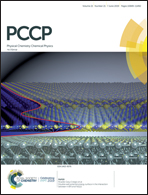The interactions of an Aβ protofibril with a cholesterol-enriched membrane and involvement of neuroprotective carbazolium-based substances†
Abstract
Recent studies have shown that the aggregation of the amyloid-beta peptide (Aβ) in the brain cell membrane is responsible for the emergence of Alzheimer's disease (AD); the exploration of effective factors involved in the extension of the aggregation process and alternatively the examination of an effective inhibitor via theoretical and experimental tools are among the main research topics in the field of AD treatment. Therefore, in this study, we used all-atom molecular dynamics (MD) simulations to clarify the impact of cell membrane cholesterol on the interaction of Aβ with 1-palmitoyl-2-oleoyl-sn-glycero-3-phosphocholine (POPC) as a membrane model. Moreover, the effect of the P7C3-S243 molecule on the abovementioned process was investigated. The simulation results disclosed the neuroprotective property of the P7C3-S243 molecule. The MD simulation results indicate that the interaction of cholesterol molecules with the Aβ oligomer is negligible and cannot enhance membrane rupture. However, strong hydrogen bonding between the POPC molecules and the oligomers led to membrane perturbation. According to our modellings, the P7C3-S243 molecular layer can protect the cell membrane by inhibiting the direct interaction between the bilayer and Aβ. In addition, free-energy calculations were conducted to determine the possible penetration of Aβ fibrils into the cholesterol-enriched membrane.



 Please wait while we load your content...
Please wait while we load your content...